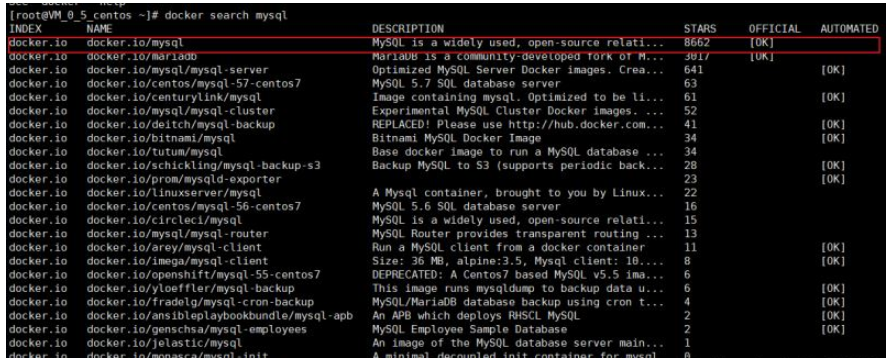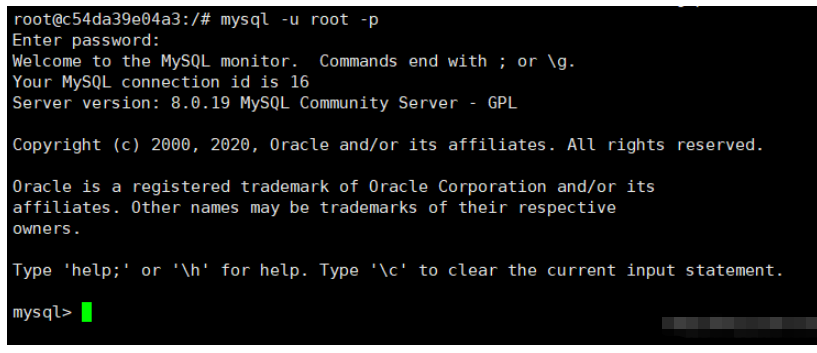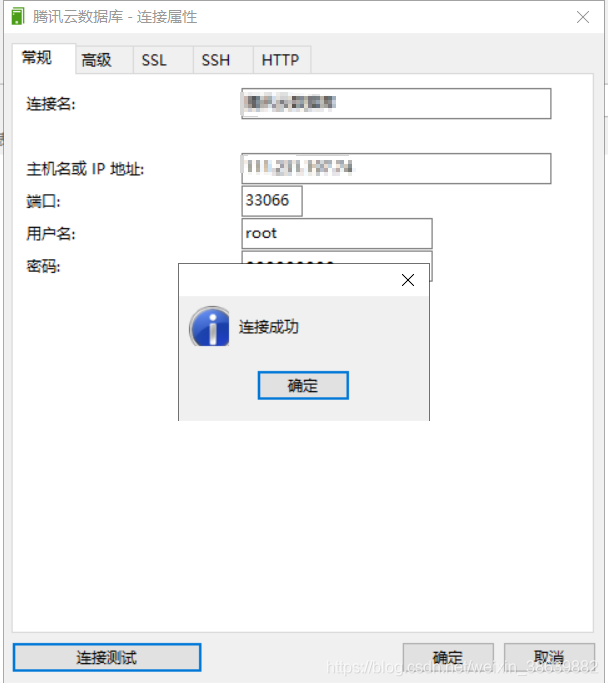How docker deploy mysql8 and set up remote connection
The key to docker deployment of mysql lies in two points
In order to avoid data loss, we need to mount the data folder generated by mysql in the production environment outside the container instead of placing it Inside the container, because storage inside the container is unsafe.
2. When running the mysql mirror, you need to set an initial password, and set mysql to be able to connect remotely.
Next we start docker to deploy mysql
First we search for the mysql image:
docker search mysql
Lists many mysql images, we choose the A

We use docker to pull down the mysql image
docker pull mysql
Docker runs the mysql image
docker run -itd --name=mysql -p 3306:3306 -v /www/docker/course/mysql/:/var/lib/mysql/ -e MYSQL_ROOT_PASSWORD=mmr702351mysql -d mysql -i 表示交互模式运行容器 -t 为容器分配一个伪输入终端 -d 表示后台运行容器 并返回容器Id -v 把mysql产生的数据同步到本地 防止数据丢失 -e 容器传参 设置mysql的初始密码 -d 镜像名
Copy and paste the above command without thinking Run and enter! If the operation returns a string of IDs, it means success.
We use docker ps to look at the running image list, and we will find that the mysql service has been run successfully. You're done!

mysql resets the password and allows remote connections (you don’t need to read the additional courses)
First we need to enter the mysql container, Use the following command
docker exec -it mysql /bin/bash
The running effect is as follows

Careful students found that there is an ID marked in the red box, indicating that we have entered the mysql container
Next we enter the following command to enter mysql management. You need to enter the mysql password (set above)
mysql -u root -p


When the above screen appears, it is clear that we have entered mysql
We can use the command to check which databases there are

And reset the password and settings to remotely connect the command As follows, run the following command directly and return OK, which means the operation is successful
ALTER USER 'root'@'%' IDENTIFIED WITH mysql_native_password BY '123456';
Next try to connect with navivat and you're done!

The above is the detailed content of How docker deploy mysql8 and set up remote connection. For more information, please follow other related articles on the PHP Chinese website!

Hot AI Tools

Undresser.AI Undress
AI-powered app for creating realistic nude photos

AI Clothes Remover
Online AI tool for removing clothes from photos.

Undress AI Tool
Undress images for free

Clothoff.io
AI clothes remover

Video Face Swap
Swap faces in any video effortlessly with our completely free AI face swap tool!

Hot Article

Hot Tools

Notepad++7.3.1
Easy-to-use and free code editor

SublimeText3 Chinese version
Chinese version, very easy to use

Zend Studio 13.0.1
Powerful PHP integrated development environment

Dreamweaver CS6
Visual web development tools

SublimeText3 Mac version
God-level code editing software (SublimeText3)

Hot Topics
 1655
1655
 14
14
 1414
1414
 52
52
 1307
1307
 25
25
 1253
1253
 29
29
 1227
1227
 24
24
 Laravel Introduction Example
Apr 18, 2025 pm 12:45 PM
Laravel Introduction Example
Apr 18, 2025 pm 12:45 PM
Laravel is a PHP framework for easy building of web applications. It provides a range of powerful features including: Installation: Install the Laravel CLI globally with Composer and create applications in the project directory. Routing: Define the relationship between the URL and the handler in routes/web.php. View: Create a view in resources/views to render the application's interface. Database Integration: Provides out-of-the-box integration with databases such as MySQL and uses migration to create and modify tables. Model and Controller: The model represents the database entity and the controller processes HTTP requests.
 Solve database connection problem: a practical case of using minii/db library
Apr 18, 2025 am 07:09 AM
Solve database connection problem: a practical case of using minii/db library
Apr 18, 2025 am 07:09 AM
I encountered a tricky problem when developing a small application: the need to quickly integrate a lightweight database operation library. After trying multiple libraries, I found that they either have too much functionality or are not very compatible. Eventually, I found minii/db, a simplified version based on Yii2 that solved my problem perfectly.
 Laravel framework installation method
Apr 18, 2025 pm 12:54 PM
Laravel framework installation method
Apr 18, 2025 pm 12:54 PM
Article summary: This article provides detailed step-by-step instructions to guide readers on how to easily install the Laravel framework. Laravel is a powerful PHP framework that speeds up the development process of web applications. This tutorial covers the installation process from system requirements to configuring databases and setting up routing. By following these steps, readers can quickly and efficiently lay a solid foundation for their Laravel project.
 MySQL and phpMyAdmin: Core Features and Functions
Apr 22, 2025 am 12:12 AM
MySQL and phpMyAdmin: Core Features and Functions
Apr 22, 2025 am 12:12 AM
MySQL and phpMyAdmin are powerful database management tools. 1) MySQL is used to create databases and tables, and to execute DML and SQL queries. 2) phpMyAdmin provides an intuitive interface for database management, table structure management, data operations and user permission management.
 MySQL vs. Other Programming Languages: A Comparison
Apr 19, 2025 am 12:22 AM
MySQL vs. Other Programming Languages: A Comparison
Apr 19, 2025 am 12:22 AM
Compared with other programming languages, MySQL is mainly used to store and manage data, while other languages such as Python, Java, and C are used for logical processing and application development. MySQL is known for its high performance, scalability and cross-platform support, suitable for data management needs, while other languages have advantages in their respective fields such as data analytics, enterprise applications, and system programming.
 Solve MySQL mode problem: The experience of using the TheliaMySQLModesChecker module
Apr 18, 2025 am 08:42 AM
Solve MySQL mode problem: The experience of using the TheliaMySQLModesChecker module
Apr 18, 2025 am 08:42 AM
When developing an e-commerce website using Thelia, I encountered a tricky problem: MySQL mode is not set properly, causing some features to not function properly. After some exploration, I found a module called TheliaMySQLModesChecker, which is able to automatically fix the MySQL pattern required by Thelia, completely solving my troubles.
 Docker on Linux: Containerization for Linux Systems
Apr 22, 2025 am 12:03 AM
Docker on Linux: Containerization for Linux Systems
Apr 22, 2025 am 12:03 AM
Docker is important on Linux because Linux is its native platform that provides rich tools and community support. 1. Install Docker: Use sudoapt-getupdate and sudoapt-getinstalldocker-cedocker-ce-clicotainerd.io. 2. Create and manage containers: Use dockerrun commands, such as dockerrun-d--namemynginx-p80:80nginx. 3. Write Dockerfile: Optimize the image size and use multi-stage construction. 4. Optimization and debugging: Use dockerlogs and dockerex
 MySQL: Essential Skills for Beginners to Master
Apr 18, 2025 am 12:24 AM
MySQL: Essential Skills for Beginners to Master
Apr 18, 2025 am 12:24 AM
MySQL is suitable for beginners to learn database skills. 1. Install MySQL server and client tools. 2. Understand basic SQL queries, such as SELECT. 3. Master data operations: create tables, insert, update, and delete data. 4. Learn advanced skills: subquery and window functions. 5. Debugging and optimization: Check syntax, use indexes, avoid SELECT*, and use LIMIT.




